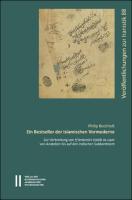Ein Bestseller der islamischen Vormoderne
Zur Verbreitung von Ḫvāndamīrs Ḥabīb as-siyar von Anatolien bis auf den indischen Subkontinent
Author(s)
Bockholt, Philip
Collection
AG UniversitätsverlageLanguage
GermanAbstract
The Persian world history “Ḥabīb al-siyar” is one of the most copied historiographical works in Islamic intellectual history. Written by the Iranian historian Khvāndamīr in Herat during the rule of the Shiʿi Safavids in the 1520s, the book was subsequently adapted to the religious and political expectations of his later patrons, the Sunni Mughals in India, and circulated through hundreds of copies spread across the entire eastern Islamic world. In „Ein Bestseller der islamischen Vormoderne“ (“An Early Modern Bestseller”), Philip Bockholt analyses copies of the work and offers new insights into their readership at various locations in the premodern Islamic world. Taking cues from reception, provenance, and historical readership studies, he examines ownership and readership notes, endowment seals and illustrations in order to shed light on the owners and readers of the work between the 16th and early 20th centuries. By giving an in-depth analysis of marginal notes found in the extant copies, he situates the “Ḥabīb al-siyar” within the broader framework of Islamic book culture and shows that the chronicle was part of a larger canon of texts. This canon was read within a greater Persianate world including not only the Safavid court in Iran and the Mughal court in India, but also places on the Deccan as well as in Central Asia and the Ottoman Empire. This study thus offers comprehensive insights into the transregional transmission of Persian historiography as well as regionally specific readership practices. Die persische Weltchronik „Ḥabīb as-siyar“ ist eines der am häufigsten kopierten Geschichtswerke der islamischen Geistesgeschichte. Das vom iranischen Historiker Ḫvāndamīr im safavidischen Herat der 1520er-Jahre verfasste Werk wurde für verschiedene Herrscher nach ihrer jeweiligen konfessionellen Präferenz mit einem schiitischen bzw. sunnitischen Schwerpunkt ausgerichtet und zirkulierte in den Jahrhunderten nach seiner Entstehung in Hunderten von Abschriften in der gesamten östlichen islamischen Welt. Philip Bockholt untersucht in seinem Buch „Ein Bestseller der islamischen Vormoderne“ die Wege dieser Abschriften durch die Hände unterschiedlicher Besitzer und Bibliotheken und analysiert anhand von Besitz- und Stiftungsstempeln, Lesevermerken und Illustrationen die Leserschaft des Werkes vom 16. bis ins beginnende 20. Jahrhundert. Hierbei werden Fragen der Rezeptions-, Provenienz- und historischen Leserforschung aufgegriffen und das „Ḥabīb as-siyar“ als persisches Geschichtswerk im Kontext der islamischen Buchkultur verortet. Wie die Analyse der ausgewerteten paratextuellen Elemente der Handschriftentradition zeigt, war das „Ḥabīb as-siyar“ Teil eines weitreichenden Kanons von Texten an Herrscher- bzw. Fürstenhöfen einer persophonen Großregion, die nicht nur den Safavidenhof in Iran und den Mogulhof in Indien, sondern auch Knotenpunkte auf dem Dekkan und in Zentralasien sowie die Hauptstadt des Osmanischen Reiches umfasste. Die Studie bietet daher Einblicke in die transregionale Rezeptionsgeschichte persischsprachiger Geschichtsschreibung und Dynamiken regionaler Lesepraxis.


 Download
Download Web Shop
Web Shop